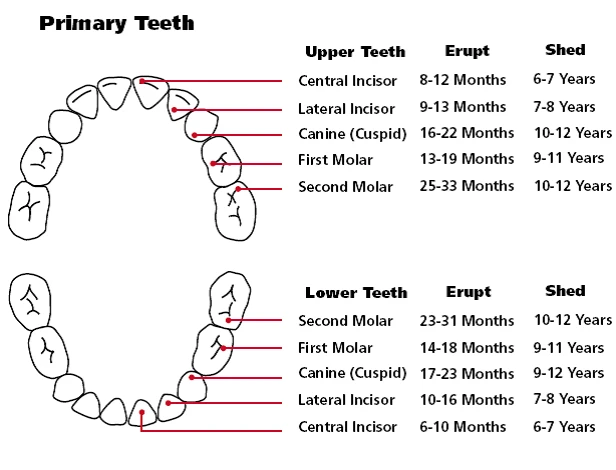There’s a lot of charts and measurements when you’re a mama. You’ve probably had your baby’s weight and length tracked on growth charts since day one. But now your baby is getting a bit older, and there’s a new chart to look at – a baby teeth chart!
If your baby is drooling like there’s no tomorrow and biting on anything that comes within an inch of their mouth, then yep, you guessed it – your baby is teething! Time to see what’s going on through a baby teeth chart.
Although baby teeth will eventually fall out, they play an important role in shaping your baby’s face, helping with speech development, and of course, laying the foundations for their adult teeth. While teething can cause your baby to be unusually fussy, seeing those first pearly whites pop through is a huge milestone.
So, here’s how baby teeth charts work, and what you can expect with a teething baby!
In this article: 📝
- Teething timeline
- Which teeth are most painful for babies?
- When do baby teeth fall out?
Teething timeline
When do babies teethe? It starts when they get their first teeth, which is usually around 6 months, but can be as early as 3 months or as late as 12 months or beyond. And it lasts until their second molars have come in, which happens between 2 and 3 years old.
What order do baby teeth come in?
So now we know when teething might start, but what order can you expect your baby’s teeth to come in? Well, that’s where a baby teething chart comes in! Most babies will follow a similar baby teeth order of eruption until all 20 baby teeth (also called primary or deciduous teeth) have cut through the gums.
Our tooth chart shows the average age range for each tooth’s eruption.

The two bottom central incisors (the middle front teeth) are usually the first to appear, between 6-10 months of age, followed by the two top central incisors between 8-12 months. The two top lateral incisors will probably emerge at a similar time, between 9-13 months, before the bottom lateral incisors at 10-16 months.
It’s common for pairs of teeth to erupt around the same time, and you might notice that in all the pairs of teeth, your baby cuts the right or left one first each time. Or it might be mixed up! Either way is normal, so no need to sweat it!
When do molars come in?
Is that a bit of popcorn stuck in their gum, or has your toddler cut a molar?! Yikes! No wonder they might be pretty crabby — the molars are much bigger teeth than the others and can take a few weeks to fully emerge. It’s common for the molars to erupt from around 13 months of age, but, as with anything baby-talk, there is a huge range of “normal.”
Another thing to know is that the molars often cut before the canines, so it’s normal for there to be a bit of a gap between the molars and incisors for the canines to fill in later on.
How many teeth should a 1 year old have?
Most 1-year-olds might have between 4 and 8 teeth, but many babies who start teething later or earlier than average may have more — or may still have none.
If your 12-month-old hasn’t got any teeth yet, be patient. Babies might show signs of teething for months before the first tooth appears. Signs a tiny baby tooth might be on the way are typically rosy cheeks, LOTS of dribble, and your baby clamping their gums around anything that comes close to their mouth — be it a teether, their spoon or sippy cup, or your fingers!
Which teeth are most painful for babies?
A tricky question to ask, seeing as none of us will actually remember teething once we’re old enough to answer!
The first tooth to erupt can cause a fair amount of fussiness, as your baby will be new to this kind of feeling and might be unsettled as they figure out what’s going on. Molars are also thought to be more painful than other teeth, due to their larger size and the length of time it often takes for them to fully emerge.
But all babies will go through teething their own way. Some may be very fussy, unsettled, and picky about food while teething, while others may not seem bothered at all.
A vast range of symptoms can be attributed to teething, but it’s important not to dismiss all physical ailments as teething. The American Dental Association says that rashes, fever, and diarrhea are not associated with teething and should be treated appropriately.
When do baby teeth fall out?
Not only does the tooth eruption chart show which order you can expect to see those pearly whites, but it also gives you an idea of when your child might start losing their baby teeth to make way for their permanent teeth.
Are you wondering at what age baby teeth fall out? Well, as always, there’s a wide range of normal. After the age of 4, your child’s facial bones and jaw will grow, creating gaps between their baby teeth, and more space for their permanent teeth to reside.
As you will see on the baby teeth growth chart, at around age 6 to 7 years of age, your child will likely lose their first baby teeth. Around this age, they will also have their first permanent teeth come in (more molars at the back of the mouth). Generally, the baby teeth will fall out in the same order that they originally cut through, and all baby teeth will have fallen out by around 12 years of age.

